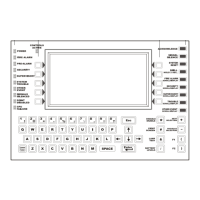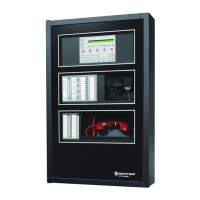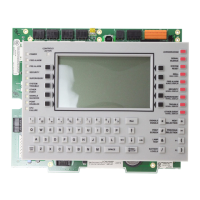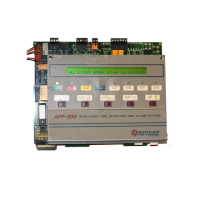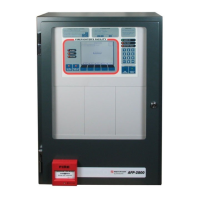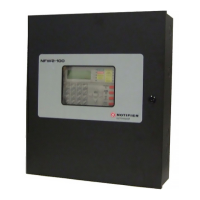68 NFS-320/E/C, NFS-320SYS/E Operations Manual — P/N 52747:E1 06/16/2011
Appendix D: Point and System Troubles Lists
There are a variety of point or system trouble types that may appear in a trouble message. The
tables below give lists of the troubles and indications of their cause.
D.1 Point (Device) Troubles
A message from the “Trouble Type” column in the following table will appear in the upper right corner of
the panel display when a point (device) trouble occurs. Use this table to help determine what the trouble is.
POINT TROUBLES
TROUBLE TYPE TROUBLE DESCRIPTION ACTION
AC FAILURE The auxiliary power supply has lost AC power. Determine whether there is an AC power loss or whether
the power supply and wiring is correct.
ADRFLT Detector and new sounder base address doesn’t match. Or the ACPS
address is incorrect.
Readdress the incorrect device.
ALIGN A beam detector is in configuration mode. No action is necessary, as the trouble will clear when the
configuration is complete. However, the detector will not
detect a fire while this trouble exists.
BLOCK Something has come between the detector’s beam and its reflector. Investigate and clear the blockage.
CHGFLT* The power supply’s battery charger is not working properly. Correct the fault.
CO 6MN The CO (carbon monoxide) detection element on the detector has six
months left to expiration. (This trouble generates in FlashScan mode
only. CLIP mode will generate a LO VAL error.)
Replace the detector.
CO EXP The CO (carbon monoxide) detection element on the detector has
reached the expiration date. (This trouble generates in FlashScan mode
only. CLIP mode will generate a LO VAL error.)
Replace the detector.
CO TBL The CO element on the detector is not working properly. (This trouble
generates in FlashScan mode only. CLIP mode will generate a LO VAL
error.)
Replace the detector.
DIRTY 1 The detector is dirty and needs cleaning Clean the detector.
DIRTY 2 The detector requires cleaning immediately. It is a false alarm risk. Clean the detector immediately.
DISABL The point has been disabled. Service and re-enable the point.
GNDFLT There is a ground fault on the main or auxiliary power supply. Correct the fault.
HI BAT The auxiliary power supply’s battery charge is too high. Check the batteries for problems. Replace batteries if
necessary.
INVREP The device has returned a response to the panel that the panel did not
expect.
Check the device for functionality, addressing and wiring.
IR TBL The infrared element is not working properly on the detector. (This
trouble generates in FlashScan mode only. CLIP mode will generate a
LO VAL error.)
Replace the detector.
LO BAT The auxiliary power supply’s battery is low. Check the batteries for problems. Replace batteries if
necessary.
LO TEMP The temperature read by a Heat+ or Acclimate™+ detector is too low. Raise the heat in the area of the detector.
LO VAL The detector chamber reading is too low; the detector is not operating
properly. Or (CLIP Mode only) the thermistors, CO element, or infra-red
element on
the detector is not working properly, or they are
experiencing a freeze warning.
The detector must be removed and replaced by an
authorized service representative.
NO ANS The device (module or detector) is not responding to the poll. Either the
device is not working or it is not connected properly.
Determine whether the device is functional, and
connected and addressed properly on the SLC.
NO SIG The device (module or detector) is not responding to the poll. Either the
device is not working or it is not connected properly.
Determine whether the device is functional, and
connected and addressed properly on the SLC.
OPEN The module device has an open circuit on its supervised wiring. Check the connections from the module to the input or
output device to which it is wired.
PRLOSS The output module or new sounder base lost power. Turn power back on.
PSFAIL The power supply is not working properly. Check the battery for problems. Replace battery if
necessary.
SHORT The module device has a short circuit on its supervised wiring. Check the connections from the module to the input or
output device to which it is wired.
TEST F This detector has failed the FACP’s periodic detector test for alarm
capabilities.
The detector should be removed and replaced by an
authorized service representative.
*This trouble may be fire panel or backup battery related. Test and replace backup batteries if necessary.
Table D.1 Point (Device) Troubles (1 of 2)
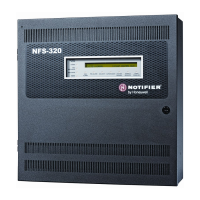
